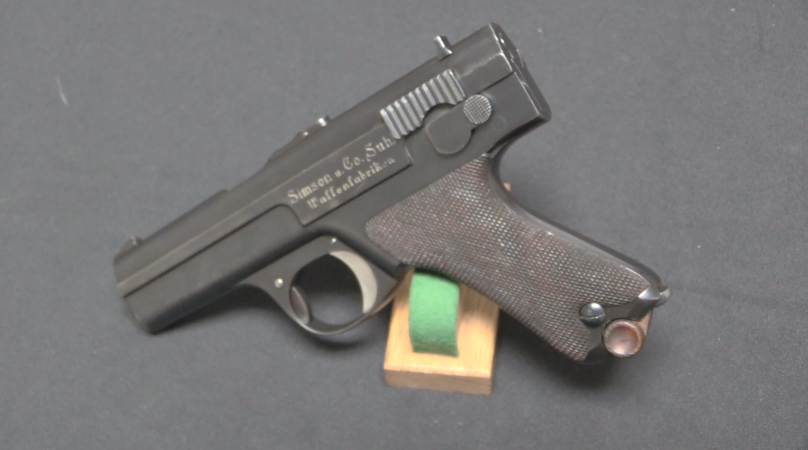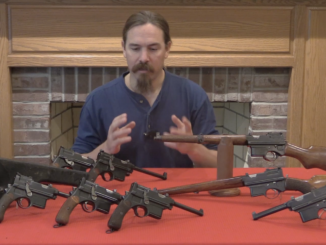By the beginning of 1945, the Nazi government in Germany was looking to find cheaper ways to equip the Volksturm, and solicited bids and designs from several major arms manufacturers. The Steyr company created a crude but effective version of the Mauser 98 which was dubbed the VK-98 or VG-5. Mechanically it is identical to a K98k, but has much less attention paid to aesthetic finish and many simplified parts.
In total, 10,000 of these Steyr rifles were made. Despite commonly held notions of them having totally random parts, there are actually a relatively small number of discreet variations in the production sequence and the rifles have definitely class characteristics – which I will examine in the video.




Just like Maroszek early rifle – that is KP-32.
Maroszek KP-32 which was simplified version of Karabinek wz. 29 never enter mass production, however it action was later rescaled and used in wz. 35 AT rifle. Now I wonder: does Steyr designers examined wz. 35 AT rifle?
Seeing this has got me wondering, while this is clearly a design out of desperation, how much could it be improved to instead simply be a ‘budget K98’?
Having never handled one, what are the advantages on a K98 to finishing out the forgings and properly finishing the exterior of the barrel? Or could you get a basically equal rifle by giving it a more finished stock for ergonomics, original stocks, and adding a butt plate, swing swivels and base-plate to make the design a bit more rugged.
Basically, if someone had more foresight what would be a viable happy medium in between this and the k98 in terms of ease of manufacture/viability as a combat rifle, what can be ignored as simply aesthetics, what should be kept for ergonomics, ease of use/ dependability?
1. A properly finished, laminated beechwood or birch stock with sling swivels fore and aft “underneath”, plus a proper buttplate.
2. An adjustable rear sight. Nothing fancy, one similar to the M1 Carbine rear sight or the Springfield M1903A3’s, graduated from 100 to about 400 yards (or meters) would be sufficient for all practical use of a rifle in 7.9 x 57 (or most similar calibers). An M1 type “eared” front sight would be nice, but one with a Kar98 type “shroud” would work, too.
3. Drill and tap the receiver for scope bases.
4. Give the outside a reasonably smooth finish and either Parkerize or chemical-blue it. (In the modern day, the Bruniton finish is both attractive, durable, relatively cheap, and fast to apply.)
A rifle like this should be reasonably cheap, safe, and adequate for 99% of all shooting that may rationally be attempted from the shoulder with a “major caliber” rifle (i.e., one chambered for a full-power cartridge rather than an “intermediate”, which should be restricted to under 200 meters).
Elmer Keith and Jeff Cooper summed it up best.
Keith; Any remote homestead should have a rifle capable of accurate aimed fire out to 300 yards.
Cooper; Other than in wartime, a survival situation, or on a target range, anyone who attempts a shot with a rifle beyond 400 meters should be required to explain, in writing and in triplicate, why it was necessary to do so.
cheers
eon
In Small Arms of the World, 9th edition, W.H.B. Smith states that at least part of VK-98 production used 10-round K-43 semiautomatic rifle magazines. of course he also states that a lot oft VK-98s were single-shots with no magazine at all, leading me to wonder if he had examined more than one or two that may have been “one-offs”.
The late-war Arisaka really wasn’t as crude as you might think. Its major difference with the standard Type 99 was that it had a cast-iron receiver. This sounds petty unsafe even with the relatively low-pressure Arisaka rounds until you realize that thy changed the design so that the bolt locking recesses weren’t in the receiver any more. Instead, they were in the barrel extension that threaded into the front end of the receiver.
All the receiver did at that point was hold the barrel and bolt in line with each other; it didn’t really need to take a lot of pressure or stress, so cast iron was “good enough” for the job. Today, the Savage 110 rifle series uses a variant of this same arrangement.
There are a lot of myths and assumptions about late-war axis small arms that need to be cleared up. For instance, the “Gerat Potsdam” SMG, a supposed counterfeit Sten gun intended for use by such “stay-after” units as the “Werwolf” bands that never actually got up and running.
Supposedly, DWM made 10,000 Sten MK II copies in early 1945, complete to British proof marks and everything. at the samne time, they made an unknown umber of a “simplified” Sten MK II, the MP 3008, which was much cruder, used MP38/40 magazines, but at least would feed, fire, and eject.
The MP 3008s definitely existed, but I suspect the “Gerat Potsdam” didn’t, because it wasn’t really needed. Because of Operation NORDPOL;
https://en.wikipedia.org/wiki/Englandspiel
According to David Kahn in The Codebreakers, among the supplies “delivered” to the Abwehr by the British as a result of “The England Game” were over 5,000 Sten MK IIs.
With that many “real” ones available, tooling up to make “fake” ones wouldn’t make much sense. I suspect that the “Nordpol Stens” were the origin of the “Gerat Potsdam” story.
cheers
eon
The last ditch Arisaka is still better than most improvised “bang sticks” or “insurgency weapons” used by people who want to steal better weapons for their cause.
“Its major difference with the standard Type 99 was that it had a cast-iron receiver.”
You’re confusing two different guns here. There was a “Naval Special” Type 99 made with a cast receiver and there was the Type 99 with late war features and the bolt and receiver was forged and milled. They both used the same 7.7×58 round, the “Naval Special’s” bolt locks into the barrel instead of the receiver, kinda like an AR-15. The “Naval Special” was only created because the IJN couldn’t get enough rifles since the IJA controlled the arsenals.
Can’t say I have the highest respect for Smith.
In the copy I’ve still not given away yet, the entry for the FG42 spends 2/3 of its length propagandising any American gun with any feature the FG42 has, but still fails to spot the Lewis ancestry.
I wouldn’t even bet on Smith having had hold of the guns. For automatics, most of his content is cribbed from Chinn.
I agree. I suspect the “Potsdam Stens” were in fact part of the cover story for NORDPOL. Soldiers in every armed force are incurable blabbermouths and a false story attached to a real weapon will be believed and circulated, preempting deeper questions. If it causes the Western Allies to waste time and resources trying to find and attack a nonexistent factory, so much the better.
There was no MP 3008.
3008 was merely drawing number/index for interlnal(that is manufactuter) purposes.
Whatever it was called, here it is;
http://world.guns.ru/smg/de/mp300-e.html
And here;
http://cdn.historynet.com/wp-content/uploads/image/2009/worldwar2/feb2010/ww2-feb2010-infograph-lrg.jpg
And here’s one that pretty definitely isn’t a postwar “faker”;
http://stenguns.tripod.com/sitebuildercontent/sitebuilderpictures/MP3008.jpg
It may not necessarily have been called the “MP 3008”, but there were certainly some around.
cheers
eon
There is a Great Potsdam Sten copy in the Mauser museum
Speaking of the STEN, I’d think that a cheap, stamped steel subgun would be a better issue weapon for the Volksturm than a bolt action full-caliber rifle. A STEN knockoff utilizing MP-40 magazines, and lots and lots of 9mm ammo.
Spray and pray, baby!
It worked pretty well for the Reds and the PPSh. Right?
One problem was they didn’t have lots of ammo. In W. Darrin Weaver’s book ‘Desperate Measures’ there is some information on that.
In the end, it was somewhat to late for them to create an fully effective militia. It was at least a year to late to start getting arms, ammunition and equipment for them, IMO.
But for what it was, the Volkstrum did some good. I know one guy who as a 3 year old orphan was escorted out of East Prussia by the Volkstrum to the west.
“stamped steel subgun would be a better issue weapon for the Volksturm than a bolt action full-caliber rifle”
Remember that hunting was quite popular sport, so many people has experience with bolt-action rifle, often Mauser system. Older can have experience with Mauser rifle from First World War.
A while back Ian filmed a facility a large collection of 22 long rifle K98 rifles, used by pre-war civilians for recreational shooting in Germany.
As these units contained the very young and the very old, the very young may have trained with a 22 caliber K98 and the very old carried one in The Great War, as Daweo pointed out.
Why would you counterbore a newly produced barrel instead of just using shorter barrels, saving the steel? I understand that counterboring serves to get rid of worn out/bad rifling which shouldn’t be an issue on new barrels — am I mistaken or am I missing other reasons for counterboring?
Thanks to anyone in advance for any insights 🙂
In reference to the Gerät Potsdam, yes, there is one on display in Oberndorf am Neckar in the Mauser Museum and if you know them (see Desperate measures), you can spot most of the differences fairly easily. The myth about the Potsdam is the non-existent British markings and broad arrows as even the fire selector is marked E for Einzelfeuer and D for Dauerfeuer.
Unless its accuracy was that bad, it’s amazing that a rifle with a powerful cartridge like this one, had merely a 100 meter sight.
Sure that was standard on VS rifles, but at least give this one a 200m zero !